Nursing 10 Report: Reducing Restraint and Seclusion Practices
VerifiedAdded on 2022/08/29
|11
|2700
|47
Report
AI Summary
This report critically examines the practice of restraint and seclusion within mental health services, focusing on its impact on both consumers and healthcare professionals. It delves into the negative consequences of these practices, including increased trauma, potential for self-harm, and dehumanization, while also addressing the ethical dilemmas faced by healthcare providers. The report emphasizes the importance of trauma-informed care and the crucial role of Registered Nurses (RNs) in reducing the use of restraint and seclusion through proactive strategies such as creating supportive environments, fostering communication, and collaborating with the care team. It highlights the need for RNs to adhere to legal considerations, policy guidelines, and national initiatives, such as the Mental Health Act 2014, to minimize the use of restrictive practices and improve the overall quality of mental healthcare. The report concludes by stressing the significance of viewing restraint and seclusion as a last resort, advocating for a shift towards more compassionate and patient-centered approaches to mental health treatment.
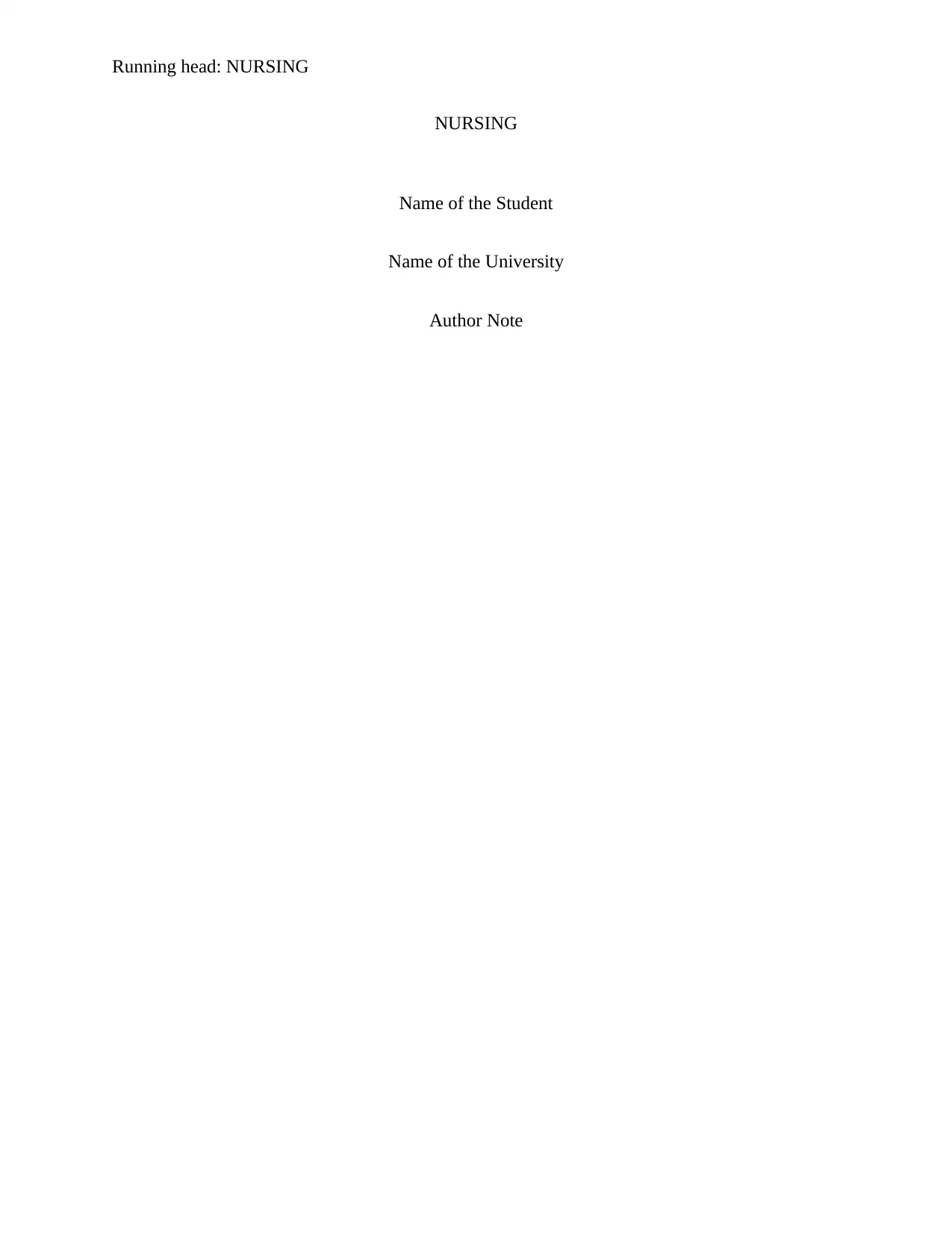
Running head: NURSING
NURSING
Name of the Student
Name of the University
Author Note
NURSING
Name of the Student
Name of the University
Author Note
Paraphrase This Document
Need a fresh take? Get an instant paraphrase of this document with our AI Paraphraser
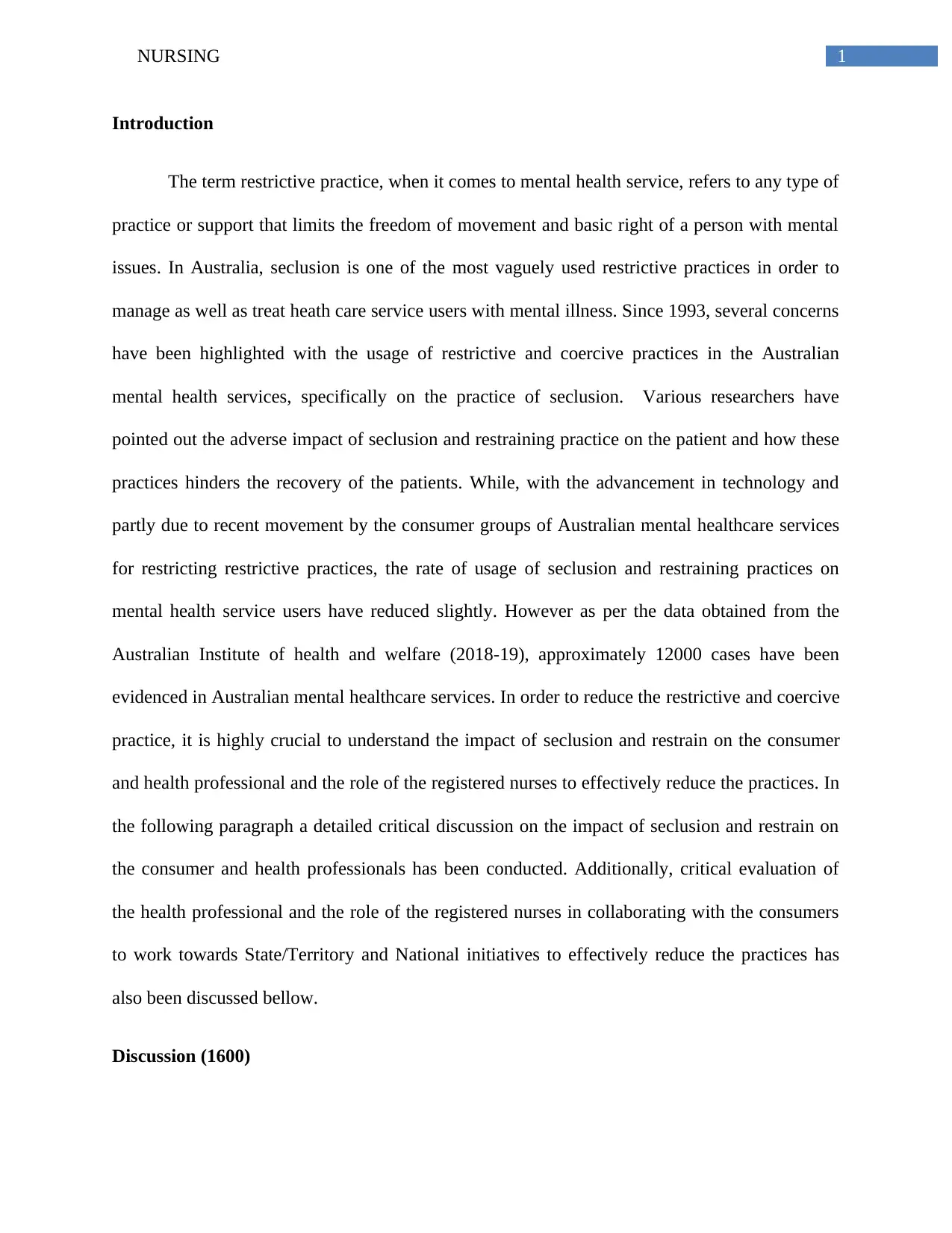
1NURSING
Introduction
The term restrictive practice, when it comes to mental health service, refers to any type of
practice or support that limits the freedom of movement and basic right of a person with mental
issues. In Australia, seclusion is one of the most vaguely used restrictive practices in order to
manage as well as treat heath care service users with mental illness. Since 1993, several concerns
have been highlighted with the usage of restrictive and coercive practices in the Australian
mental health services, specifically on the practice of seclusion. Various researchers have
pointed out the adverse impact of seclusion and restraining practice on the patient and how these
practices hinders the recovery of the patients. While, with the advancement in technology and
partly due to recent movement by the consumer groups of Australian mental healthcare services
for restricting restrictive practices, the rate of usage of seclusion and restraining practices on
mental health service users have reduced slightly. However as per the data obtained from the
Australian Institute of health and welfare (2018-19), approximately 12000 cases have been
evidenced in Australian mental healthcare services. In order to reduce the restrictive and coercive
practice, it is highly crucial to understand the impact of seclusion and restrain on the consumer
and health professional and the role of the registered nurses to effectively reduce the practices. In
the following paragraph a detailed critical discussion on the impact of seclusion and restrain on
the consumer and health professionals has been conducted. Additionally, critical evaluation of
the health professional and the role of the registered nurses in collaborating with the consumers
to work towards State/Territory and National initiatives to effectively reduce the practices has
also been discussed bellow.
Discussion (1600)
Introduction
The term restrictive practice, when it comes to mental health service, refers to any type of
practice or support that limits the freedom of movement and basic right of a person with mental
issues. In Australia, seclusion is one of the most vaguely used restrictive practices in order to
manage as well as treat heath care service users with mental illness. Since 1993, several concerns
have been highlighted with the usage of restrictive and coercive practices in the Australian
mental health services, specifically on the practice of seclusion. Various researchers have
pointed out the adverse impact of seclusion and restraining practice on the patient and how these
practices hinders the recovery of the patients. While, with the advancement in technology and
partly due to recent movement by the consumer groups of Australian mental healthcare services
for restricting restrictive practices, the rate of usage of seclusion and restraining practices on
mental health service users have reduced slightly. However as per the data obtained from the
Australian Institute of health and welfare (2018-19), approximately 12000 cases have been
evidenced in Australian mental healthcare services. In order to reduce the restrictive and coercive
practice, it is highly crucial to understand the impact of seclusion and restrain on the consumer
and health professional and the role of the registered nurses to effectively reduce the practices. In
the following paragraph a detailed critical discussion on the impact of seclusion and restrain on
the consumer and health professionals has been conducted. Additionally, critical evaluation of
the health professional and the role of the registered nurses in collaborating with the consumers
to work towards State/Territory and National initiatives to effectively reduce the practices has
also been discussed bellow.
Discussion (1600)

2NURSING
Impact of the seclusion and restrain on the consumer and health professional
It has been clearly stated in the Mental Health Act 2009, restraining and seclusion
practices are not therapeutic interventions. While retraining practice includes usage of
physical force, mechanical devices or chemical for immobile the patient, seclusion, also a
type of restraining practice includes confining the patient from which he or she cannot
exit freely.
Therefore, as per the restraint and seclusion in Mental Health Services Policy Guideline,
restrain and seclusion should be used as the last resort by health professional when all the
other option for managing the patient failed and for the need of ensuring safety of the
patient, his or her family members as well as healthcare service providers. The chief
reason behind considering the process of seclusion and restraining to be the last option to
manage the mental patients is that this practices possess the potential is to impose a good
number of negative impact on the mental as well as physical health of the patient and thus
can worsen his/her mental condition.
Andersson and Palm (2017) have stated that one of the major impacts of seclusion on patients
with metal issue is trauma leading to severe depression, anxiety, self injury and even suicidal
activities. Keeping the patients alone in a separate room makes in majority of the cases
enhances the feeling of distress during the time of restrain. Being restrained physically, possess
high potential to bring back the memories of previous truma experienced by the patient and ths
can leads to retraumatising. This may amplify the urge of conducting aggressive behaviour and
self harm. According to Quinn et al. (2019), both seclusion and restrain puts patients at the risk
Impact of the seclusion and restrain on the consumer and health professional
It has been clearly stated in the Mental Health Act 2009, restraining and seclusion
practices are not therapeutic interventions. While retraining practice includes usage of
physical force, mechanical devices or chemical for immobile the patient, seclusion, also a
type of restraining practice includes confining the patient from which he or she cannot
exit freely.
Therefore, as per the restraint and seclusion in Mental Health Services Policy Guideline,
restrain and seclusion should be used as the last resort by health professional when all the
other option for managing the patient failed and for the need of ensuring safety of the
patient, his or her family members as well as healthcare service providers. The chief
reason behind considering the process of seclusion and restraining to be the last option to
manage the mental patients is that this practices possess the potential is to impose a good
number of negative impact on the mental as well as physical health of the patient and thus
can worsen his/her mental condition.
Andersson and Palm (2017) have stated that one of the major impacts of seclusion on patients
with metal issue is trauma leading to severe depression, anxiety, self injury and even suicidal
activities. Keeping the patients alone in a separate room makes in majority of the cases
enhances the feeling of distress during the time of restrain. Being restrained physically, possess
high potential to bring back the memories of previous truma experienced by the patient and ths
can leads to retraumatising. This may amplify the urge of conducting aggressive behaviour and
self harm. According to Quinn et al. (2019), both seclusion and restrain puts patients at the risk
⊘ This is a preview!⊘
Do you want full access?
Subscribe today to unlock all pages.

Trusted by 1+ million students worldwide
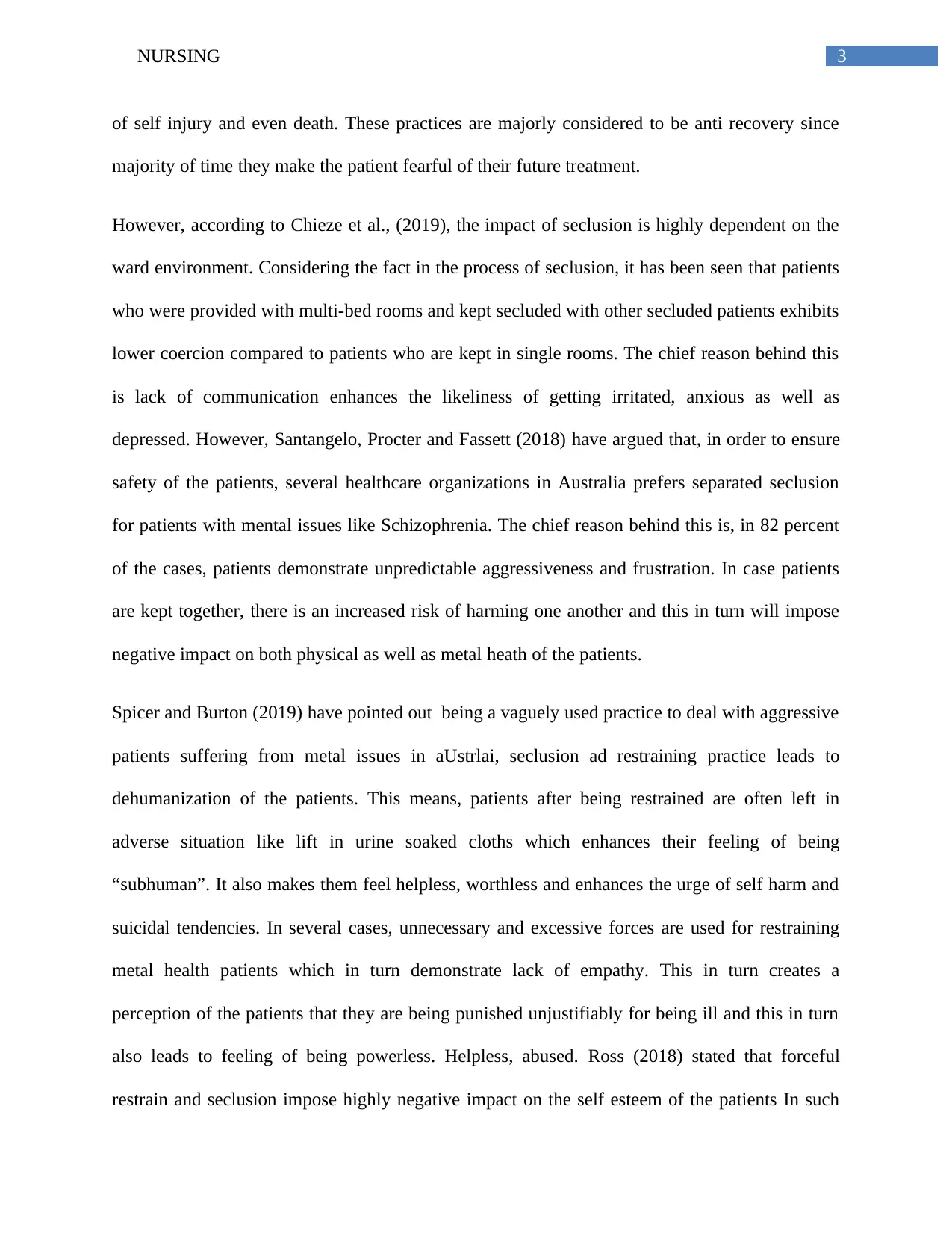
3NURSING
of self injury and even death. These practices are majorly considered to be anti recovery since
majority of time they make the patient fearful of their future treatment.
However, according to Chieze et al., (2019), the impact of seclusion is highly dependent on the
ward environment. Considering the fact in the process of seclusion, it has been seen that patients
who were provided with multi-bed rooms and kept secluded with other secluded patients exhibits
lower coercion compared to patients who are kept in single rooms. The chief reason behind this
is lack of communication enhances the likeliness of getting irritated, anxious as well as
depressed. However, Santangelo, Procter and Fassett (2018) have argued that, in order to ensure
safety of the patients, several healthcare organizations in Australia prefers separated seclusion
for patients with mental issues like Schizophrenia. The chief reason behind this is, in 82 percent
of the cases, patients demonstrate unpredictable aggressiveness and frustration. In case patients
are kept together, there is an increased risk of harming one another and this in turn will impose
negative impact on both physical as well as metal heath of the patients.
Spicer and Burton (2019) have pointed out being a vaguely used practice to deal with aggressive
patients suffering from metal issues in aUstrlai, seclusion ad restraining practice leads to
dehumanization of the patients. This means, patients after being restrained are often left in
adverse situation like lift in urine soaked cloths which enhances their feeling of being
“subhuman”. It also makes them feel helpless, worthless and enhances the urge of self harm and
suicidal tendencies. In several cases, unnecessary and excessive forces are used for restraining
metal health patients which in turn demonstrate lack of empathy. This in turn creates a
perception of the patients that they are being punished unjustifiably for being ill and this in turn
also leads to feeling of being powerless. Helpless, abused. Ross (2018) stated that forceful
restrain and seclusion impose highly negative impact on the self esteem of the patients In such
of self injury and even death. These practices are majorly considered to be anti recovery since
majority of time they make the patient fearful of their future treatment.
However, according to Chieze et al., (2019), the impact of seclusion is highly dependent on the
ward environment. Considering the fact in the process of seclusion, it has been seen that patients
who were provided with multi-bed rooms and kept secluded with other secluded patients exhibits
lower coercion compared to patients who are kept in single rooms. The chief reason behind this
is lack of communication enhances the likeliness of getting irritated, anxious as well as
depressed. However, Santangelo, Procter and Fassett (2018) have argued that, in order to ensure
safety of the patients, several healthcare organizations in Australia prefers separated seclusion
for patients with mental issues like Schizophrenia. The chief reason behind this is, in 82 percent
of the cases, patients demonstrate unpredictable aggressiveness and frustration. In case patients
are kept together, there is an increased risk of harming one another and this in turn will impose
negative impact on both physical as well as metal heath of the patients.
Spicer and Burton (2019) have pointed out being a vaguely used practice to deal with aggressive
patients suffering from metal issues in aUstrlai, seclusion ad restraining practice leads to
dehumanization of the patients. This means, patients after being restrained are often left in
adverse situation like lift in urine soaked cloths which enhances their feeling of being
“subhuman”. It also makes them feel helpless, worthless and enhances the urge of self harm and
suicidal tendencies. In several cases, unnecessary and excessive forces are used for restraining
metal health patients which in turn demonstrate lack of empathy. This in turn creates a
perception of the patients that they are being punished unjustifiably for being ill and this in turn
also leads to feeling of being powerless. Helpless, abused. Ross (2018) stated that forceful
restrain and seclusion impose highly negative impact on the self esteem of the patients In such
Paraphrase This Document
Need a fresh take? Get an instant paraphrase of this document with our AI Paraphraser

4NURSING
cases, patients are more likely to blame themselves for adverse situations and this in turn lowers
their urge to get recovered from the mental issues.
According to researchers, being secluded and restrained can lead to the feelings of distress,
specially in case of prolonged seclusion and restrain. Along with the patients, prolonged
seclusion has been find to be highly stressful for the family members of the healthcare
consumers. It is a common instance in mental healthcare where prolonged seclusion and restrain
of one of the family members have lead to major psychological distress amongst his or her
family members. Majority of the family members of the patients are found to subjected to major
anxiety, depression and even aggression as a result of the hostile attitudes of the healthcare
professional on the patients.
Chieze et al. (2019) have stated that one of the basic requirements of consumers with
psychological disorders includes compassionate attitudes as well as mental support from the
healthcare service providers. Seclusion and restrain practices being just the opposite of this
requirements enhances distrust and fear amongst the patients. Patients can be fearful of the
healthcare staffs, which may assist with physical discipline. In comparison, a lack of inhibition
can also encourage patients to behave themselves aggressively.
Along with patients, seclusion also impose a huge impact on the healthcare professional. The
first impact of seclusion and restraining on the health care professional is development of distrust
and deterioration of bonding between the healthcare service user and providers. This in turn,
impose negative impact on the recovery rate of the patient and thus he quality of care provided
by the healthcare professionals. sahealth.sa.gov.au. (2020) have stated that healthcare
professionals gets subjected to ethical dilemma while practicing seclusion and restrain between
cases, patients are more likely to blame themselves for adverse situations and this in turn lowers
their urge to get recovered from the mental issues.
According to researchers, being secluded and restrained can lead to the feelings of distress,
specially in case of prolonged seclusion and restrain. Along with the patients, prolonged
seclusion has been find to be highly stressful for the family members of the healthcare
consumers. It is a common instance in mental healthcare where prolonged seclusion and restrain
of one of the family members have lead to major psychological distress amongst his or her
family members. Majority of the family members of the patients are found to subjected to major
anxiety, depression and even aggression as a result of the hostile attitudes of the healthcare
professional on the patients.
Chieze et al. (2019) have stated that one of the basic requirements of consumers with
psychological disorders includes compassionate attitudes as well as mental support from the
healthcare service providers. Seclusion and restrain practices being just the opposite of this
requirements enhances distrust and fear amongst the patients. Patients can be fearful of the
healthcare staffs, which may assist with physical discipline. In comparison, a lack of inhibition
can also encourage patients to behave themselves aggressively.
Along with patients, seclusion also impose a huge impact on the healthcare professional. The
first impact of seclusion and restraining on the health care professional is development of distrust
and deterioration of bonding between the healthcare service user and providers. This in turn,
impose negative impact on the recovery rate of the patient and thus he quality of care provided
by the healthcare professionals. sahealth.sa.gov.au. (2020) have stated that healthcare
professionals gets subjected to ethical dilemma while practicing seclusion and restrain between

5NURSING
beneficence and non-maleficence associated with the safety of the patient, his/her family
members and staffs. Considering the fact that these practices are taken in extreme cases when all
other measures fails., healthcare professional undergoes agitation and frustration to get involve in
practices like seclusion and restrain. However, Knox and Holloman Jr (2012) argued that
sensitized healthcare professional who gets involved in seclusion and restraining practices
majority of the time are found to be subjected to excessive stress, social exclusion and poor work
life balance. They also experience excessive emotional turmoil, exhaustion and emotional
burnout while dealing with the patients.
Thus it can be said that in majority of cases, the practice of seclusion and restrain has been found
to impose highly negative impact on physical and metal heath of both the patients as well as the
service providers along with diminishing the recovery rate of the patients.
Role of RNs towards national and territorial initiatives for reducing seclusion and
restraint
Several national and territorial initiatives has been taken by the local as well as federal
government of Australia in order to reduce unnecessary seclusion and restraint practices from the
nation. Some of the major policies include the Mental Health Act 2014 that provides a set of
guidelines for nurses so that the practice of seclusion and restraint can be reduced to an effective
level. As per the act, any restrictive and coercive practices like seclusion and restrain should be
taken by healthcare professionals and nurses in extreme cases. The Restraint and Seclusion in
Mental Health Services Policy Guideline, designed by the south Australian government have
also provided a detailed instruction for RNs so that the practices can be reduced. The chief role
of the Registered nurses in collaboration with the patients to reduce seclusion and restraint
practices are stated in the following paragraphs.
beneficence and non-maleficence associated with the safety of the patient, his/her family
members and staffs. Considering the fact that these practices are taken in extreme cases when all
other measures fails., healthcare professional undergoes agitation and frustration to get involve in
practices like seclusion and restrain. However, Knox and Holloman Jr (2012) argued that
sensitized healthcare professional who gets involved in seclusion and restraining practices
majority of the time are found to be subjected to excessive stress, social exclusion and poor work
life balance. They also experience excessive emotional turmoil, exhaustion and emotional
burnout while dealing with the patients.
Thus it can be said that in majority of cases, the practice of seclusion and restrain has been found
to impose highly negative impact on physical and metal heath of both the patients as well as the
service providers along with diminishing the recovery rate of the patients.
Role of RNs towards national and territorial initiatives for reducing seclusion and
restraint
Several national and territorial initiatives has been taken by the local as well as federal
government of Australia in order to reduce unnecessary seclusion and restraint practices from the
nation. Some of the major policies include the Mental Health Act 2014 that provides a set of
guidelines for nurses so that the practice of seclusion and restraint can be reduced to an effective
level. As per the act, any restrictive and coercive practices like seclusion and restrain should be
taken by healthcare professionals and nurses in extreme cases. The Restraint and Seclusion in
Mental Health Services Policy Guideline, designed by the south Australian government have
also provided a detailed instruction for RNs so that the practices can be reduced. The chief role
of the Registered nurses in collaboration with the patients to reduce seclusion and restraint
practices are stated in the following paragraphs.
⊘ This is a preview!⊘
Do you want full access?
Subscribe today to unlock all pages.

Trusted by 1+ million students worldwide

6NURSING
In majority of the cases, seclusion and restraint are provided to consumers who gets
unpredictably aggressive and with highly low metal stability (Brophy et al.2016). It is the role of
RN to take each and every measures possible to prevent implication of seclusion and restraint
practices. For instances, providing trauma informed care should implemented by the RNs.
Considering the fact that trauma survivors are more likely to fright, fight or flight responses,
their psychological turmoil can be kept in control while providing treatment through the
following practices. It is the role of the RNs to
1. Create an environment that is welcoming
2. Providing options in case of outsets and thus ensure that the patient is not feeling trapped
or confined
3. Minimizing stimuli hat are aversive and unnecessary
4. Asking permission before touching the patient
5. Communicating with the patients and thus creating a healthcare service provider-service
user bond.
6. Building a philosophy of cooperation in the organization and with the team members.
7. An RN should be Prepared to collaborate and take over in coordination with team
members where customer contact is no longer a proactive solution.
8. Ensuring that the organization has job awareness about the Human Prevention Program
(HPP) of the client while an individual is in place.
As an RN, it is highly crucial for the healthcare professional to understand the impact of
seclusion and restrain on the mental and physical well being of the consumers. Hence, before
making any decision, he or she should consult with other nurses and the physicians in order to
ensure that the decision made is not abrupt or unnecessary. According to Kinner et al. (2017), it
In majority of the cases, seclusion and restraint are provided to consumers who gets
unpredictably aggressive and with highly low metal stability (Brophy et al.2016). It is the role of
RN to take each and every measures possible to prevent implication of seclusion and restraint
practices. For instances, providing trauma informed care should implemented by the RNs.
Considering the fact that trauma survivors are more likely to fright, fight or flight responses,
their psychological turmoil can be kept in control while providing treatment through the
following practices. It is the role of the RNs to
1. Create an environment that is welcoming
2. Providing options in case of outsets and thus ensure that the patient is not feeling trapped
or confined
3. Minimizing stimuli hat are aversive and unnecessary
4. Asking permission before touching the patient
5. Communicating with the patients and thus creating a healthcare service provider-service
user bond.
6. Building a philosophy of cooperation in the organization and with the team members.
7. An RN should be Prepared to collaborate and take over in coordination with team
members where customer contact is no longer a proactive solution.
8. Ensuring that the organization has job awareness about the Human Prevention Program
(HPP) of the client while an individual is in place.
As an RN, it is highly crucial for the healthcare professional to understand the impact of
seclusion and restrain on the mental and physical well being of the consumers. Hence, before
making any decision, he or she should consult with other nurses and the physicians in order to
ensure that the decision made is not abrupt or unnecessary. According to Kinner et al. (2017), it
Paraphrase This Document
Need a fresh take? Get an instant paraphrase of this document with our AI Paraphraser

7NURSING
is the responsibility of an RN to take all the legal considerations and observe the polices and
guidelines set by the healthcare institution before making any decision or applying seclusion or
restraint.
Conclusion
In conclusion, it can be said that both the practice of seclusion and restraining leads to
deteriorating the chance of recovery of the metal healthcare consumers. Not only this, these
practices are considered to lack empathy towards the patients and increase the chance of self
herm, suicidal attempts and other physical injuries and enhancement of metal disorder of the
patients. Hence, it is highly crucial for healthcare professionals to consider seclusion and
restraining practices as the last choice to manage the condition of consumers and eliminate
unnecessary usage of this practice. Considering the fact that Registered Nurses plays a major role
in preventing unnecessary and abrupt seclusion and restraint practise and thus reduce usage of
the practices in metal health care homes, it has become highly crucial for RNs to implement the
above discuss strategies and ensure that these painful practices has been reduced to an effective
level.
is the responsibility of an RN to take all the legal considerations and observe the polices and
guidelines set by the healthcare institution before making any decision or applying seclusion or
restraint.
Conclusion
In conclusion, it can be said that both the practice of seclusion and restraining leads to
deteriorating the chance of recovery of the metal healthcare consumers. Not only this, these
practices are considered to lack empathy towards the patients and increase the chance of self
herm, suicidal attempts and other physical injuries and enhancement of metal disorder of the
patients. Hence, it is highly crucial for healthcare professionals to consider seclusion and
restraining practices as the last choice to manage the condition of consumers and eliminate
unnecessary usage of this practice. Considering the fact that Registered Nurses plays a major role
in preventing unnecessary and abrupt seclusion and restraint practise and thus reduce usage of
the practices in metal health care homes, it has become highly crucial for RNs to implement the
above discuss strategies and ensure that these painful practices has been reduced to an effective
level.
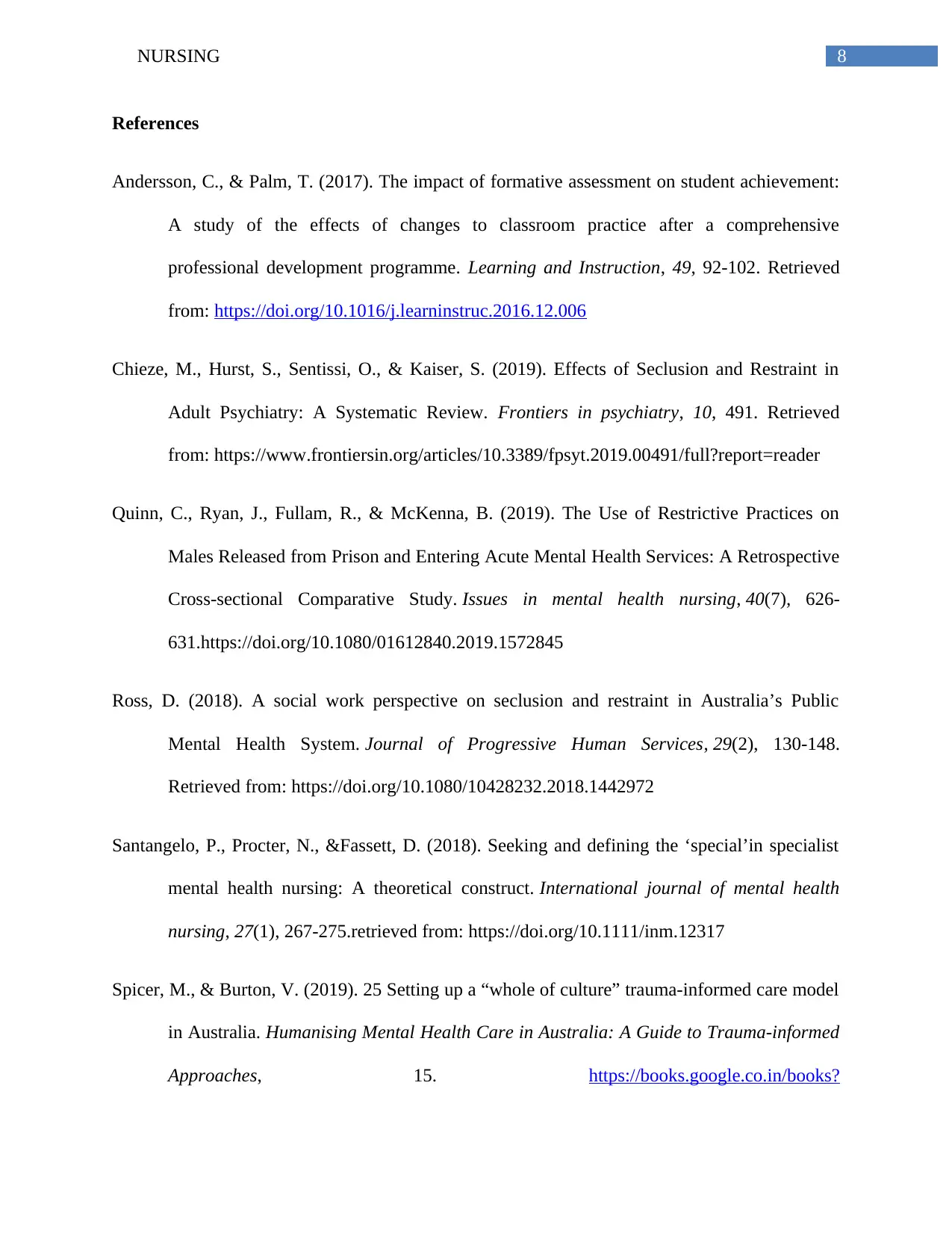
8NURSING
References
Andersson, C., & Palm, T. (2017). The impact of formative assessment on student achievement:
A study of the effects of changes to classroom practice after a comprehensive
professional development programme. Learning and Instruction, 49, 92-102. Retrieved
from: https://doi.org/10.1016/j.learninstruc.2016.12.006
Chieze, M., Hurst, S., Sentissi, O., & Kaiser, S. (2019). Effects of Seclusion and Restraint in
Adult Psychiatry: A Systematic Review. Frontiers in psychiatry, 10, 491. Retrieved
from: https://www.frontiersin.org/articles/10.3389/fpsyt.2019.00491/full?report=reader
Quinn, C., Ryan, J., Fullam, R., & McKenna, B. (2019). The Use of Restrictive Practices on
Males Released from Prison and Entering Acute Mental Health Services: A Retrospective
Cross-sectional Comparative Study. Issues in mental health nursing, 40(7), 626-
631.https://doi.org/10.1080/01612840.2019.1572845
Ross, D. (2018). A social work perspective on seclusion and restraint in Australia’s Public
Mental Health System. Journal of Progressive Human Services, 29(2), 130-148.
Retrieved from: https://doi.org/10.1080/10428232.2018.1442972
Santangelo, P., Procter, N., &Fassett, D. (2018). Seeking and defining the ‘special’in specialist
mental health nursing: A theoretical construct. International journal of mental health
nursing, 27(1), 267-275.retrieved from: https://doi.org/10.1111/inm.12317
Spicer, M., & Burton, V. (2019). 25 Setting up a “whole of culture” trauma-informed care model
in Australia. Humanising Mental Health Care in Australia: A Guide to Trauma-informed
Approaches, 15. https://books.google.co.in/books?
References
Andersson, C., & Palm, T. (2017). The impact of formative assessment on student achievement:
A study of the effects of changes to classroom practice after a comprehensive
professional development programme. Learning and Instruction, 49, 92-102. Retrieved
from: https://doi.org/10.1016/j.learninstruc.2016.12.006
Chieze, M., Hurst, S., Sentissi, O., & Kaiser, S. (2019). Effects of Seclusion and Restraint in
Adult Psychiatry: A Systematic Review. Frontiers in psychiatry, 10, 491. Retrieved
from: https://www.frontiersin.org/articles/10.3389/fpsyt.2019.00491/full?report=reader
Quinn, C., Ryan, J., Fullam, R., & McKenna, B. (2019). The Use of Restrictive Practices on
Males Released from Prison and Entering Acute Mental Health Services: A Retrospective
Cross-sectional Comparative Study. Issues in mental health nursing, 40(7), 626-
631.https://doi.org/10.1080/01612840.2019.1572845
Ross, D. (2018). A social work perspective on seclusion and restraint in Australia’s Public
Mental Health System. Journal of Progressive Human Services, 29(2), 130-148.
Retrieved from: https://doi.org/10.1080/10428232.2018.1442972
Santangelo, P., Procter, N., &Fassett, D. (2018). Seeking and defining the ‘special’in specialist
mental health nursing: A theoretical construct. International journal of mental health
nursing, 27(1), 267-275.retrieved from: https://doi.org/10.1111/inm.12317
Spicer, M., & Burton, V. (2019). 25 Setting up a “whole of culture” trauma-informed care model
in Australia. Humanising Mental Health Care in Australia: A Guide to Trauma-informed
Approaches, 15. https://books.google.co.in/books?
⊘ This is a preview!⊘
Do you want full access?
Subscribe today to unlock all pages.

Trusted by 1+ million students worldwide
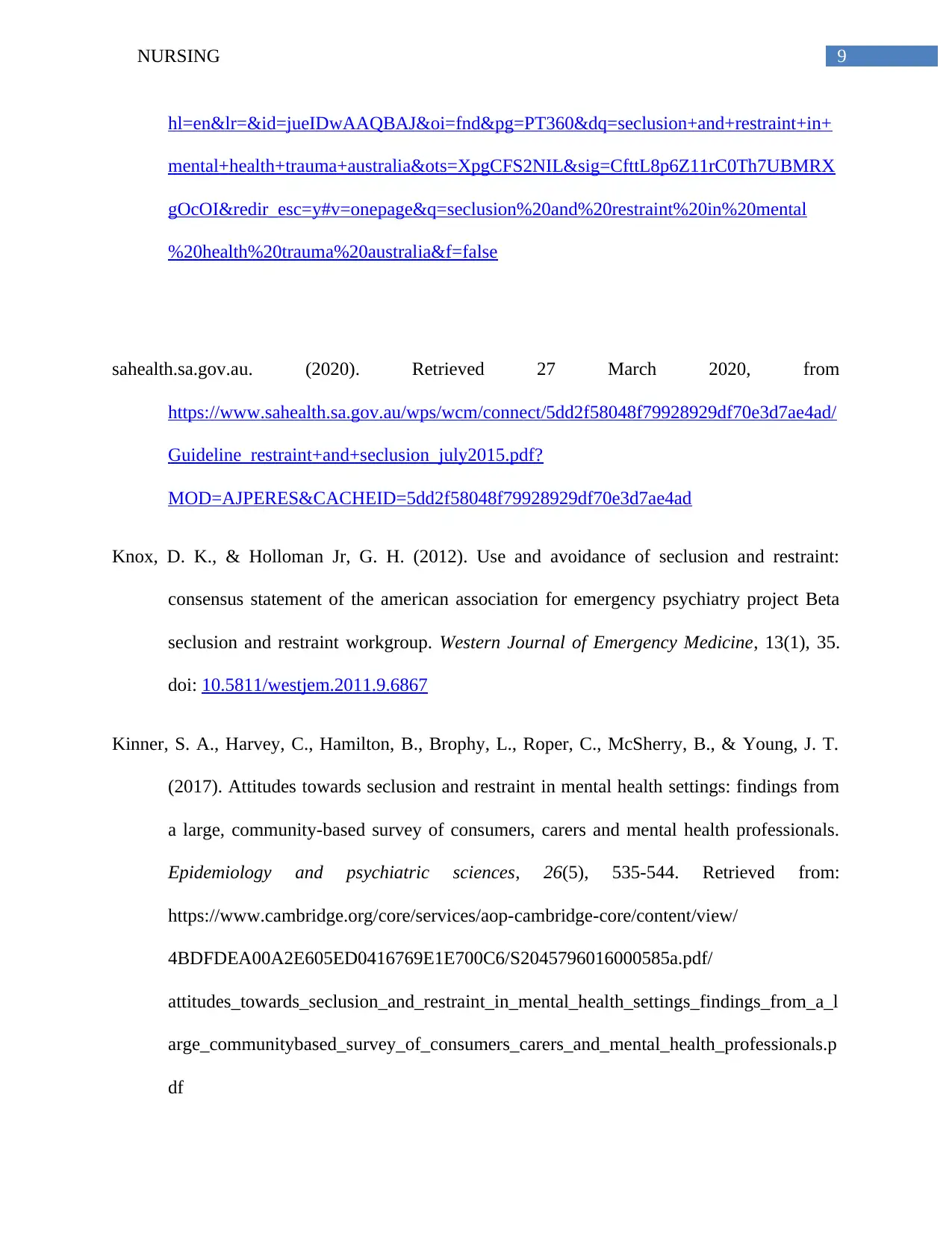
9NURSING
hl=en&lr=&id=jueIDwAAQBAJ&oi=fnd&pg=PT360&dq=seclusion+and+restraint+in+
mental+health+trauma+australia&ots=XpgCFS2NIL&sig=CfttL8p6Z11rC0Th7UBMRX
gOcOI&redir_esc=y#v=onepage&q=seclusion%20and%20restraint%20in%20mental
%20health%20trauma%20australia&f=false
sahealth.sa.gov.au. (2020). Retrieved 27 March 2020, from
https://www.sahealth.sa.gov.au/wps/wcm/connect/5dd2f58048f79928929df70e3d7ae4ad/
Guideline_restraint+and+seclusion_july2015.pdf?
MOD=AJPERES&CACHEID=5dd2f58048f79928929df70e3d7ae4ad
Knox, D. K., & Holloman Jr, G. H. (2012). Use and avoidance of seclusion and restraint:
consensus statement of the american association for emergency psychiatry project Beta
seclusion and restraint workgroup. Western Journal of Emergency Medicine, 13(1), 35.
doi: 10.5811/westjem.2011.9.6867
Kinner, S. A., Harvey, C., Hamilton, B., Brophy, L., Roper, C., McSherry, B., & Young, J. T.
(2017). Attitudes towards seclusion and restraint in mental health settings: findings from
a large, community-based survey of consumers, carers and mental health professionals.
Epidemiology and psychiatric sciences, 26(5), 535-544. Retrieved from:
https://www.cambridge.org/core/services/aop-cambridge-core/content/view/
4BDFDEA00A2E605ED0416769E1E700C6/S2045796016000585a.pdf/
attitudes_towards_seclusion_and_restraint_in_mental_health_settings_findings_from_a_l
arge_communitybased_survey_of_consumers_carers_and_mental_health_professionals.p
df
hl=en&lr=&id=jueIDwAAQBAJ&oi=fnd&pg=PT360&dq=seclusion+and+restraint+in+
mental+health+trauma+australia&ots=XpgCFS2NIL&sig=CfttL8p6Z11rC0Th7UBMRX
gOcOI&redir_esc=y#v=onepage&q=seclusion%20and%20restraint%20in%20mental
%20health%20trauma%20australia&f=false
sahealth.sa.gov.au. (2020). Retrieved 27 March 2020, from
https://www.sahealth.sa.gov.au/wps/wcm/connect/5dd2f58048f79928929df70e3d7ae4ad/
Guideline_restraint+and+seclusion_july2015.pdf?
MOD=AJPERES&CACHEID=5dd2f58048f79928929df70e3d7ae4ad
Knox, D. K., & Holloman Jr, G. H. (2012). Use and avoidance of seclusion and restraint:
consensus statement of the american association for emergency psychiatry project Beta
seclusion and restraint workgroup. Western Journal of Emergency Medicine, 13(1), 35.
doi: 10.5811/westjem.2011.9.6867
Kinner, S. A., Harvey, C., Hamilton, B., Brophy, L., Roper, C., McSherry, B., & Young, J. T.
(2017). Attitudes towards seclusion and restraint in mental health settings: findings from
a large, community-based survey of consumers, carers and mental health professionals.
Epidemiology and psychiatric sciences, 26(5), 535-544. Retrieved from:
https://www.cambridge.org/core/services/aop-cambridge-core/content/view/
4BDFDEA00A2E605ED0416769E1E700C6/S2045796016000585a.pdf/
attitudes_towards_seclusion_and_restraint_in_mental_health_settings_findings_from_a_l
arge_communitybased_survey_of_consumers_carers_and_mental_health_professionals.p
df
Paraphrase This Document
Need a fresh take? Get an instant paraphrase of this document with our AI Paraphraser
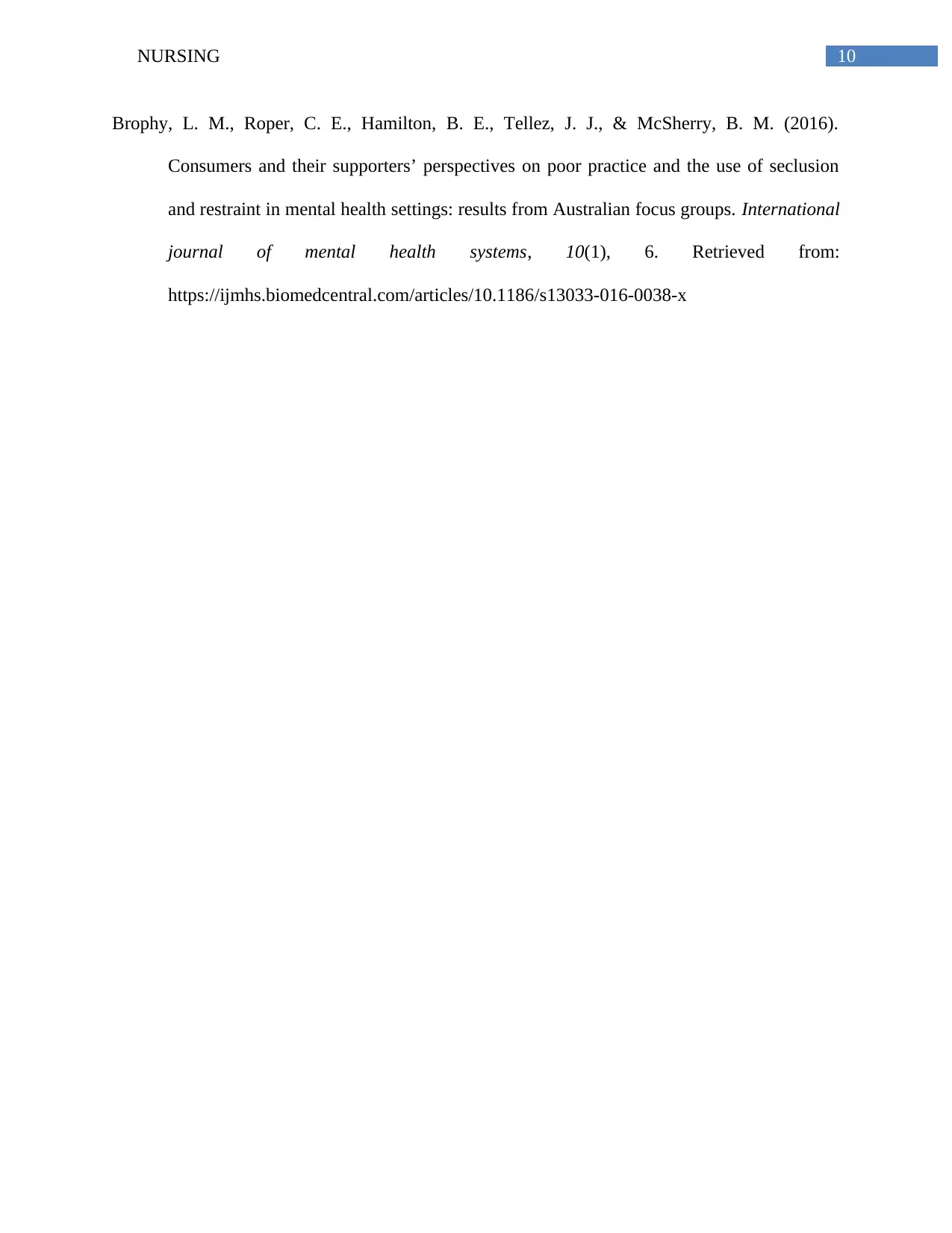
10NURSING
Brophy, L. M., Roper, C. E., Hamilton, B. E., Tellez, J. J., & McSherry, B. M. (2016).
Consumers and their supporters’ perspectives on poor practice and the use of seclusion
and restraint in mental health settings: results from Australian focus groups. International
journal of mental health systems, 10(1), 6. Retrieved from:
https://ijmhs.biomedcentral.com/articles/10.1186/s13033-016-0038-x
Brophy, L. M., Roper, C. E., Hamilton, B. E., Tellez, J. J., & McSherry, B. M. (2016).
Consumers and their supporters’ perspectives on poor practice and the use of seclusion
and restraint in mental health settings: results from Australian focus groups. International
journal of mental health systems, 10(1), 6. Retrieved from:
https://ijmhs.biomedcentral.com/articles/10.1186/s13033-016-0038-x
1 out of 11
Related Documents
Your All-in-One AI-Powered Toolkit for Academic Success.
+13062052269
info@desklib.com
Available 24*7 on WhatsApp / Email
![[object Object]](/_next/static/media/star-bottom.7253800d.svg)
Unlock your academic potential
Copyright © 2020–2025 A2Z Services. All Rights Reserved. Developed and managed by ZUCOL.





